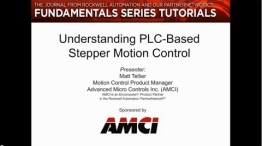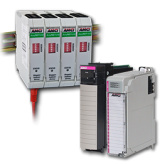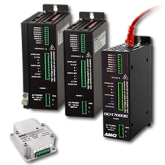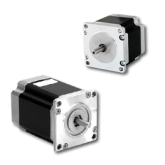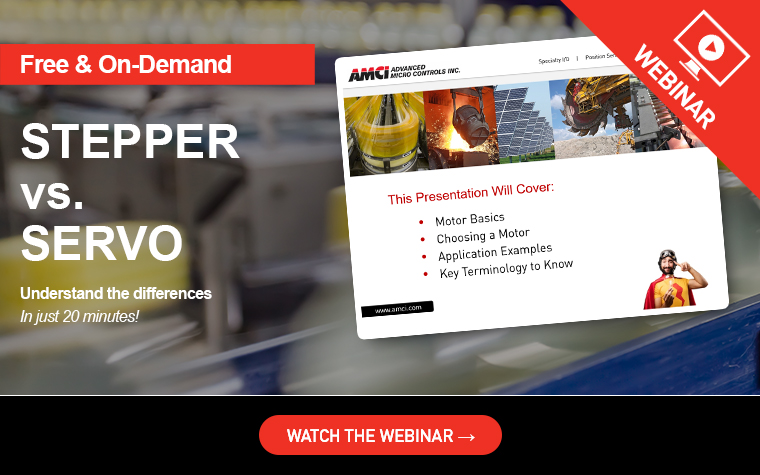A B C D E F G H I J K L M N O P Q R S T U V W X Y Z | Reference tables
Acceleration: The time rate of change in velocity. Torque developed between the rotor and stator will cause the rotor to accelerate. The inertia of the rotor and, load, if any, will resist the applied torque and thus control the rate of acceleration.
Axial Play: The axial shaft displacement due to an axial force. Also called End Play.
Anti-Resonance: All stepper motor systems are subject to mid-frequency resonance that is the result of motor generated back-EMF. Drivers equipped with the Anti-Resonance feature will modify the motors current waveforms to compensate for the back-EMF, resulting in a smoother operation at resonant speeds.
Back EMF: The voltage produced across a winding due to its interaction with the rotating magnetic field generated by the motion of the rotor. Back EMF is proportional to the velocity of the rotor and in opposition to the voltage applied to the winding by the motor drive.
Bifilar Winding: A set of electrically connected coils in which two wires are simultaneously wound together around the stator.
Bipolar Driver: A driver capable of generating current flow through a winding in both directions.
Center Tap / Common Wire: The lead wire that connects the two wires in a bifilar winding. When a motor is operated in the unipolar winding configuration current enters each winding through the center tap.
Closed Loop Control: A system of control in which the output or some result of the output is measured. This information is compared to the input to verify command execution and if necessary make adjustments.
Constant Current Driver / Chopper Driver / PWM Driver: A driver capable of adjusting the applied voltage across a winding to force and maintain rated current. A voltage is applied until the winding current reaches a pre-determined value. The supply is then switched off and it remains off unit the current decays to a second lower pre-determined value, at which time the voltage is re-applied.
Constant Voltage Driver / L/R Driver / Resistance Limited (RL) Driver: A driver that maintains a constant applied voltage across each energized winding. The flow of current is limited only by the resistance / impedance of each winding.
Controller / Indexer / Pulse Generator: A device or circuit that generates a DC pulse train that is sent to the stepper motor drive. The number and rate of pulses generated determine the number and rate of steps the motor will ultimately execute.
Current Loop Gain: Drivers equipped with this feature allow the current loop gain value to be modified. While the typical setting will work in most systems, reducing the gain will help if the motor is heavily loaded and stalling during a low speed move, or if your motor has a very low inductance value and is emitting a high frequency sound while powered.
Damping: The suppression of oscillations at the end of motion or during motion.
Detent Torque: The torque required to rotate a non-energized motor.
Driver / Drive: An electrical device that drives a stepper motor based on pulses from a controller / indexer / pulse generator. A driver translates the pulse train and energizes the appropriate stepper motor windings.
Duty Cycle: The percentage of ON time vs. OFF time. A device that is always on has a 100% duty cycle. A device that is half on and half off has a 50% duty cycle.
Efficiency: The ratio of power output to power input.
Electronic Damping: The suppression of vibration by altering the flow of current to or the step rate of a motor.
Electrical Time Constant: The time required for a motor’s windings to charge to 63% of their rated current value.
Electromotive Force / EMF: A synonym for voltage, generally used to describe generated voltage.
Encoder: A feedback device that can be used to derive positional and velocity information.
End Taps: The lead wires that terminate (end) a phase/winding.
Energize / Excite: To send current through a phase or phases of a stepper motor.
End Play: See Axial Play.
Feedback: The output or result of the output that is measured and sent back to the controller for comparison with the input during closed loop operations.
Full Step Angle: The size of an incremental move made by a stepper motor determined solely by the motor’s construction.
Full Stepping: A method of driving a stepper motor in which each incremental movement is equal to the motor’s full step angle.
Half Stepping: A method of driving a stepper motor in which its full step angle is electrically halved by alternating between energizing one or two of the motor’s phases.
Half Stepping (Modified): A method of half stepping in which the amount of current delivered to each phase is varied, depending on the number of phases energized, to generate uniform torque throughout the entire step sequence.
Holding Torque: The maximum external torque that can be applied to an energized stepper motor at 0 pps without causing rotation.
Hybrid stepper motor: A stepper motor constructed using a permanent magnet rotor and whose rotor and stator assembles are both made with tooth like projections.
Hysteresis (positional): The difference between the step positions when moving CW and the step positions when moving CCW. A stepper motor may stop slightly short of the true position, thus producing a slight difference in position CW to CCW.
Idle Current Reduction: Driver function that reduces the current supplied to the motor when no motion is occurring. While this has the advantage of reducing motor heating, it will also reduce the motor’s Holding Torque.
Inductance: The property of a winding that resists changes in current flow. Inductance is proportional to the square of the number of coil turns in each winding. The effects of inductance are especially noticeable at higher speeds.
Inertia: A physical property of matter that resists changes in speed or direction. Inertia of load affects the amount of torque required to accelerate and decelerate.
Inertia (Reflected): The apparent inertia value transmitted to a stepper motor through a gear train. The apparent value is the actual inertial value divided by the square of the gear ratio.
Mechanical Damper: A vibration reducing device that is physically attached to a stepper motor.
Microstepping: A method of driving a stepper motor in which the full step angle of a motor is reduced electrically by separately controlling the amount of current to each motor phase.
Non-Cumulative Error: Error that does not add or accumulate over multiple steps or incremental movements.
Open Loop Control: A system of control in which the motor operates without feedback.
Overshoot: Rotation of a motor beyond its commanded position.
Permanent Magnet stepper motor: A stepper motor constructed using a permanent magnet rotor and whose rotor and stator assemblies are both smooth.
Phase / Winding: A group of electrically connected coils.
Poles: Areas of a motor where a magnetic pole is generated either by a permanent magnet or by passing current through the coils of a winding.
Pole Pitch: The angle between adjacent poles of the same polarity on the rotor of a Permanent Magnet motor. The pole pitch determines the full step angle of a Permanent Magnet motor.
Pull-in Torque Curve: A graph showing the maximum torque, for a given speed, where a load can be accelerated into synchronism from a standstill.
Pull-out Torque Curve: A graph showing the maximum torque that can be applied to a stepper motor operating a given speed without losing synchronism.
Pulse: An electrical signal or voltage of short duration. Typically used to describe the signals sent from the indexer to the driver.
Pulse Rate: The rate at which successive steps are initiated or the windings switched.
Radial Play: Displacement perpendicular to the shaft due to a force applied perpendicularly to the shaft axis.
Ramping: Increasing (or decreasing) the step rate of a motor gradually to prevent the loss of synchronism.
Rated Current: The maximum allowable continuous current that the motor can handle without exceeding its temperature rating at ambient temperature (usually 25 C). It is the rated current at which the holding torque has been determined.
Rated Voltage: The voltage at which the rated torque is generated with the motor at ambient temperature. Its value is the product of rated current and winding resistance.
Repeatability: The ability to return to a previously held position.
Resolution: The amount of rotation or linear motion produced when a motor executes a single step.
Resonance: A phenomena where excessive vibration occurs due to the motor operating at a frequency at or near the natural frequency of the entire system.
Resonant Range: The range where a motor’s step rate is near the natural frequency of the motor. A motor operating in this range may experience excessive vibration.
Rotor: The rotating part of the motor.
Slew Range: The region between the pull-in and pull-out torque curves. A motor may operate in this range, but cannot start, stop, or reverse without ramping.
Stator: The stationary part of the motor.
Step: The movement of the rotor from one energized position to the next.
Step Accuracy: A measure of a stepper motor’s maximum deviation from its desired or indicated position, calculated as a percentage of the step angle. This deviation is non-cumulative, meaning that the deviation found in any number of steps is no greater than the maximum deviation found in a single step.
Step Angle: The nominal angle through which the shaft of a stepper motor turns between adjacent step positions. It is dependent upon the motor and driver sequence (full, half, or Microstepping).
Stepper Motor: An actuator that translates discrete input pulses into motion composed of discrete incremental movements.
Step Rate: The rate in steps per second at which a stepper motor is commanded to operate.
Step Sequence: The pattern in which a stepper motor’s phases are energized to generate motion.
Switching: Turning on and off voltage / current to a motor’s winding.
Synchronism: The condition is which a rotor’s rotation matches the rotation of the magnetic field created by the stator’s windings. In synchronism, the motor’s step rate equals the controller’s input pulse rate. When synchronism is lost, the motor will stall or misstep.
Teeth: Projections on the rotor and stator found in hybrid stepper motors.
Tooth Pitch: The angle between adjacent teeth on the rotor. The tooth pitch determines the full step angle of a hybrid motor.
Torque: A force that produces rotational motion.
Unipolar Driver: A driver capable of generating current flow through a winding in only one direction.
|
